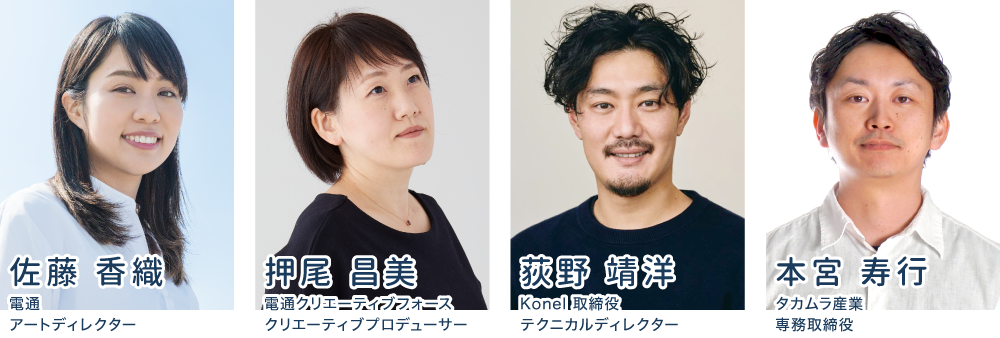Dentsu Inc.'s cross-functional creative organization, the Future Creative Center (FCC), is a group of over 80 members supporting future-building domains with creativity beyond advertising. In this series, center members discuss their actual initiatives under the theme "Future × Creativity."
This time, we reveal the development story behind the talking toy box "Goo Goo Monster," born from the 2021 FCC Idea Contest. "Goo Goo Monster" is a product that makes tidying up fun for children in the terrible twos by adding a game-like element. It began with one person's idea to create opportunities for new parent-child communication. Members who shared this vision came together, leveraging their respective skills to bring it to life.
Kaori Sato, Art Director at Dentsu Inc. FCC and the project's planner, emphasizes that "a flat and open relationship was crucial" for teaming. She reflected on the project's journey alongside Creative Producer Masami Oshio from Dentsu Creative Force, Technical Director Yasuhiro Ogino from Konel, and Toshiyuki Motomiya from Takamura Industries, responsible for cardboard manufacturing.
The Birth of the "Recovery Entertainment" Idea Supporting Parents
Sato: "Goo Goo Monster" is a "recycling entertainment" concept targeting toddlers in the terrible twos and threes, young elementary school children, and their parents. It combines cardboard boxes with smartphone image recognition. The monster-shaped box issues requests for items to be tidied away, and when toys are placed inside, it responds with various audio reactions.
Sato: The idea came from playing restaurant with a friend's child. The child asked, "What do you want to eat?" and when I replied, "I want something red," they eagerly searched for it. I thought this could be applied to tidying up. Children in the terrible twos dislike being told "Clean up!" by their parents, yet they also have a sense of "I can do it myself." I thought that by having them find and give the toys the monster orders, and receiving feedback, it could help build their sense of self-efficacy.
The monster's requests for "things to eat" vary widely—color, shape, textures like "fluffy" or "slippery," and tastes like "sweet." Random requests encourage children to use their imagination to search. We also hope this sparks new communication between parent and child, like "This looks sweet" or "Why do you think it's sweet?"
Oshio: We expanded tidying up into "Collection Entertainment" because the definition of tidying varies by household and environment. Some families don't consider simply gathering items in one spot as tidying. In places like daycare centers, it often involves sorting items by type and making them easy for the next user to find.
Sato: The Goo-Goo Monster is made of cardboard, but we also put a special touch on the outer shipping box. We printed illustrations of parts like arms and wings on it, so kids can color them, cut them out, and paste them onto the main body to customize their own monster. We included eye stickers and an introductory picture book to help parents and children enter the Goo-Goo Monster world. We designed it with a story: parents and children assemble the cardboard together, then bring it to life by adding the eyes.
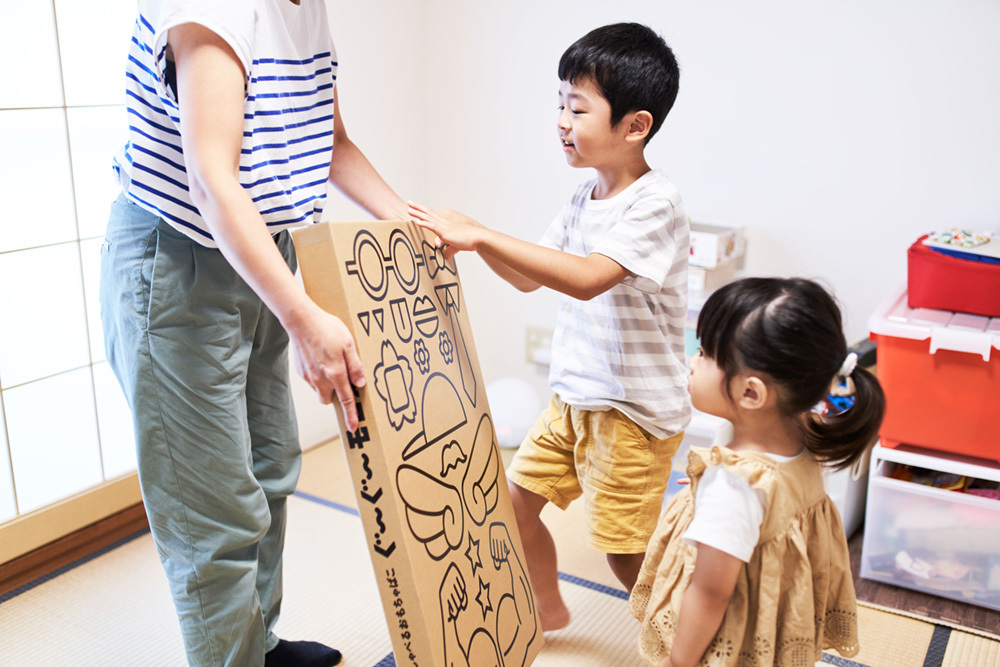
Delivery

Reading picture books
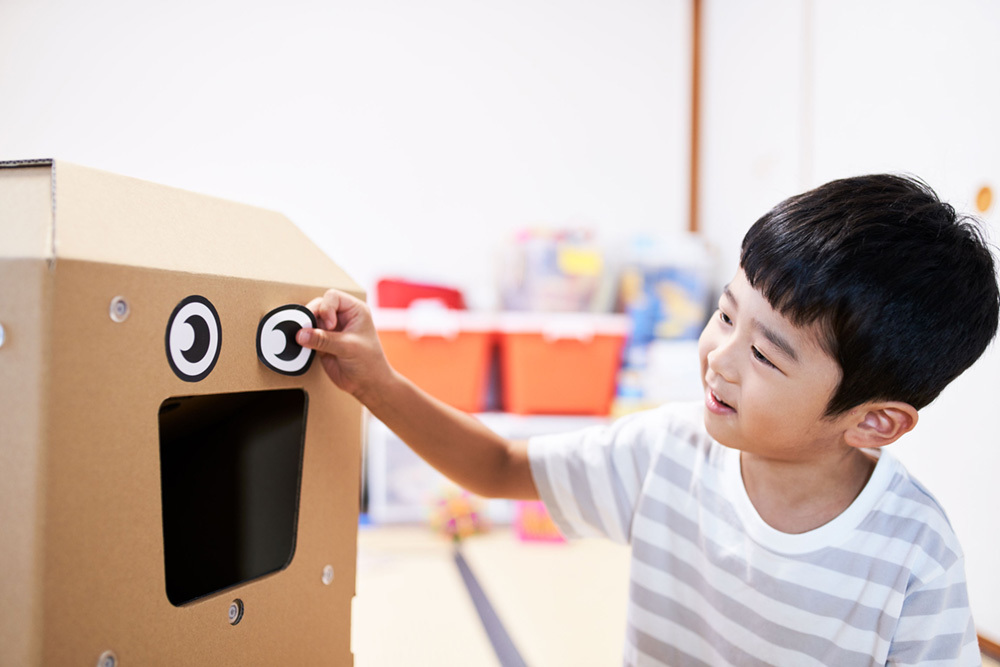
Sticking on the eyes
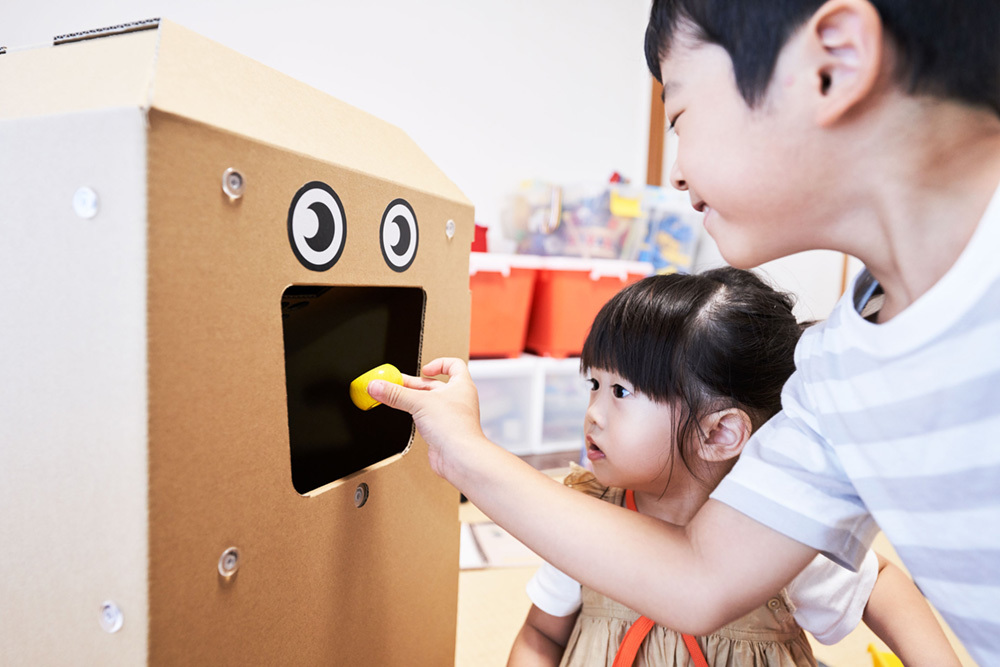
Feeding
Two technological innovations born from side-by-side skill-sharing teaming
Sato: When gathering collaborators for the project, I took my idea and openly discussed what I could and couldn't do, traveling around to consult with people. While I'm good at thinking about communication, I'm not good at putting it into practice. So, I consulted with Oshio-san, who has strong execution skills. He found the plan interesting, so I invited him to join the team. After that, I consulted with Ogino-san on the technical aspects.
Ogino: Since it was a zero-based discussion about how to shape the idea, I thought our strength in prototyping could be leveraged. As a parent of a child going through the terrible twos myself, I really resonated with this idea. For prototyping, we first built a trash can-based enclosure to test how much it resonated with children as an experience. We even tested it at my home, but unexpectedly, my son got scared and started bawling his eyes out.
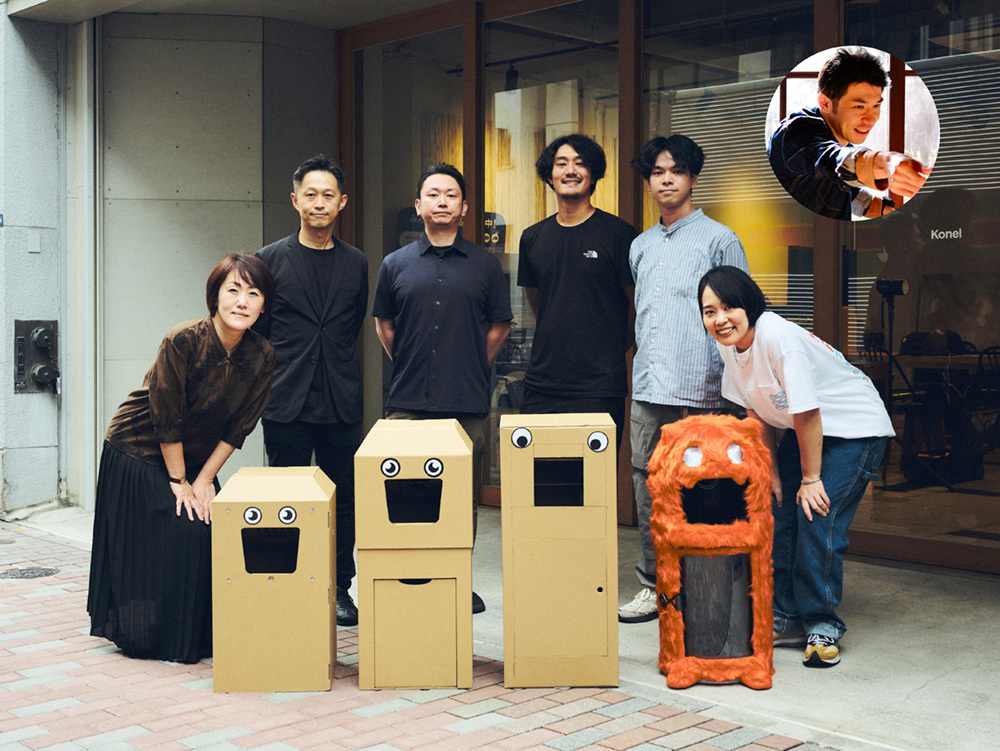
The "Goo-Goo Monster" – Four Generations of Models and Development Team (From Left): Mr. Oshio (Dentsu Creative Force), Mr. Hirose Dai (Dentsu Inc.), Mr. Motomiya (Takamura Industries), Mr. Ogino (Konel), Mr. Sato Ryusei (Konel), Mr. Sato (Dentsu Inc.), Mr. Kimizuka Fumitaka (Frontend Engineer)
Oshio: The early Coo Coo Monster was far from its current form—it was plastic, and its eyes would light up when it ate toys. Initially, we designed it as a parent-child communication tool, where parents would operate a smartphone to produce sounds. However, after gathering feedback from childcare workers and testing it in various households, we realized it actually increased the burden on parents. That's when we decided to switch to automation. When implementing the prototype, Mr. Ogino and I spent about six months discussing it, and we finally decided to make all operations complete on the smartphone. That was a major turning point, right?
Ogino: Initially, we considered creating an IoT device with a built-in speaker. But developing hardware would have made future maintenance and troubleshooting burdensome. I'm really glad we were able to make it work entirely through smartphones.
Oshio: Regarding the casing, plastic was costly, so we explored alternatives. Every day, during online meetings with Mr. Sato, we were at a loss. Then, one day, the idea to make it out of cardboard suddenly came to us. So, we searched for a company that could make even just one prototype and contacted Takamura Industries through their general inquiry form. They thought we were some shady sales pitch and didn't respond for a while (laughs). When we explained over the phone, they immediately introduced us to Mr. Motomiya.
Motomiya: When I first heard about the project, I found the idea of adding a game-like element to tidying up fascinating. I was also drawn to the concept of parents and children assembling cardboard pieces to bring them to life. While our company manufactures cardboard play equipment for children, this was our first time developing a project with such a strong narrative. I was eager to collaborate.
Sato: We formed a team by pooling our respective skills toward a shared goal, driven by our mutual desire to support parents raising children and to bring the Goo-Goo Monster to life and into the world. We wanted to foster an atmosphere where everyone could share opinions openly and equally, so we're moving forward with the production on a level playing field.
Ogino: Precisely because we could all think together while showing our cards, it was very easy for us as a team—Dentsu Inc. came up with the smartphone idea, and we proposed concepts around the experience.
Oshio: There was real fun and excitement in collaborating with companies we don't usually work with. I also realized that creativity isn't just about pushing ideas to their limits; it's essential for designing every single process. To deliver the product in a fun way, we're persistently reviewing things right up to the very end. I can't thank Ogino-san and Motomiya-san enough for always supporting us with smiles throughout.
Motomiya: We also got to work with Konel through Dentsu Inc., and it made us really excited about the possibilities of combining digital and analog.
Commercialization depends on real user reactions. Our first crowdfunding challenge
Sato: Before getting involved in this product development, I had absolutely no knowledge of the toy industry. So, together with Mr. Oshio, I obtained a toy consultant qualification and exhibited at a toy festival that drew around 1,500 visitors. The response was excellent—many children played happily with it, and some even came back multiple times.
Oshio: When we called out, "It's a talking toy box!" parents also got curious about the structure and peered inside the mouth, right? They seemed to appreciate the pleasant surprise of how the combination of cardboard and a smartphone made it function as a toy box.
Sato: We deliberately avoided emphasizing "tidying up," yet parents spontaneously remarked, "This might be good for tidying up." It was heartening to see our intent resonate. Both parents and children laughed at the Goo-goo Monster's surreal phrases like "Please call the chef." I realized that being a slightly odd presence that elicits chuckles while parents and children share the same space might be just right. After seeing how people played with it, we made improvements like adding more roundness to the head shape and adjusting the size, consulting with Motomiya-san along the way.
From idea to prototype, from prototype to user experience, crowdfunding became our first step toward commercialization. We genuinely want to gauge whether this is something the world truly needs and to gain a real sense of users' genuine reactions.
Oshio: If we can take Gugu Monster to the next level with interested parties and clients in the future, having a crowdfunding track record and a solid foundation of thorough product development consideration will broaden our scope for challenges. We also look forward to receiving advice from our supporters.
Motomiya: Typically, mass-producing cardboard products requires creating molds to keep manufacturing costs down. While our company usually makes an initial investment, launches the product, and then gauges customer response, crowdfunding offers a major advantage: it allows us to see potential sales volume before committing to mold production.
Ogino: While the Goo Goo Monster is still in the process of refining its accuracy, crowdfunding is perfect for releasing it at this stage as an experiential question. We want to get improvement feedback from people who resonate with it and those willing to help nurture it. Once this Goo Goo Monster product gains traction, I believe we can do increasingly interesting things with it.
Sato: It's an All or Nothing campaign, so if we don't reach the funding goal, we won't deliver the Goo Goo Monster. Therefore, our first priority is to make the crowdfunding campaign a success and gather user feedback. The Goo Goo Monster can freely change its size and color, and its voice can be customized too—for example, you could set it to a Kansai dialect or the voice of a parent living far away. It's not just for toys either—it can collect unwanted items like plastic bottles or clothing. This means it has the potential for broad use, appealing to people of all ages and genders. As "collection entertainment," it becomes even more fun if it can transform into various forms. We see crowdfunding as a chance to gauge reactions to the Goo-Goo Monster and explore its future possibilities.
・Click here for the "Goo-Goo Monster" crowdfunding campaign








